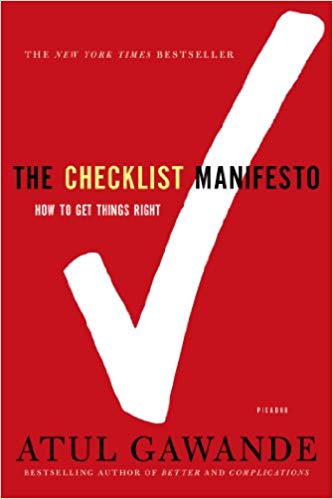

This article is an excerpt from the Shortform summary of "The Checklist Manifesto" by Atul Gawande. Shortform has the world's best summaries of books you should be reading.
Like this article? Sign up for a free trial here .
What are the advantages of checklists? How can they make you more efficient and less liable to make careless mistakes at work and at home?
We’ll cover the benefits it checklists and look at examples of the advantages of checklists in the worlds of aviation and medicine.
The Advantages of Checklists
In complex environments, checklists can help to prevent failure by addressing two problems:
Advantage of Checklists #1
1) Our memory and our attention to detail fail when we’re distracted by more urgent matters. For instance, if you’re a nurse, you might forget to take a patient’s pulse when she’s throwing up, a family member is asking questions, and you’re being paged.
Forgetfulness and distraction are especially risky in what engineers call all-or-none processes, where if you miss one key thing, you fail at the task. For instance, if you go to the store to buy ingredients for a cake and forget to buy eggs, you can’t make the recipe because it wouldn’t work without eggs. The consequences are more serious if a pilot misses a step during take-off or a doctor misses the key symptom. Regardless of the situation, aiding your memory is an advantage of checklists.
Advantage of Checklists #2
2) People have a tendency to skip steps even when they remember them. In complex processes, certain steps don’t always matter, so people may play the odds and skip them. For instance, if measuring all four of a patient’s vital signs (pulse, blood pressure, temperature, and respiration) only rarely detects a problem, you might become lax about checking everything.
Checklists protect against such failures because they remind you of the minimum necessary steps by spelling them out. They allow you to verify each step while also establishing and instilling a performance standard. This is another benefit of checklists.
Boeing Discovers the Benefits of Checklists
Let’s look at an example of how to apply the advantages of checklists in the professional world.
In 1935, the Army Air Corps asked airplane manufacturers for a new long-range bomber. Boeing’s Model 299, which exceeded specifications, was favored over models by Martin and Douglas. However, during a flight competition held by the Army in Dayton, Ohio, the Boeing model stalled at 300 feet and crashed, killing two of five crew members.
The plane was much more complicated than previous aircraft — the pilot had more steps to follow and forgot to release a new locking mechanism on the elevator and rudder controls. After the accident, a newspaper called the new model “too much airplane for one man to fly.” The Army Air Corps chose Douglas’s smaller design, and Boeing took a big financial hit.
Nonetheless, the Army bought a few Model 299s as test planes and a group of test pilots studied how to prevent future pilot errors. Instead of focusing on requiring longer training, they came up with a pilot’s checklist. Flying up to that point had not been especially complicated, but flying the new plane required too many details to be left to memory.
The test pilots made their checklist simple, clear, and concise — it fit on an index card — with step-by-step checks for takeoff, landing, and taxiing. Using the checklist, pilots went on to fly the bomber, which became the B-17 Flying Fortress, 1.8 million miles without incident. The Army ordered 13,000, and the bomber gave the allies a big air advantage in World War II.
Checklists have become essential in aviation, averting problems and accidents. In notebook and electronic forms, they’re a standard and crucial part of pilot training and aircraft operation.
These are some of the uses and advantages of checklists.
Medicine: The Advantages of Checklists
In medicine, the four vital signs (pulse, blood pressure, temperature, and respiration) have become an important regular check on how a patient is doing. Missing one can be dangerous.
Medical practitioners didn’t consistently measure and record the four vital signs until the 1960s, when nurses in Western hospitals designed patient charts that included them. Checking them off on a chart was a way of ensuring that in a busy and demanding environment, they wouldn’t forget to make the checks every six hours. Hospitals have since added a fifth vital sign, the patient’s pain level on a scale of one to ten.
In 2001, a critical care specialist at Johns Hopkins Hospital, Peter Pronovost, decided to try a checklist for doctors, targeting a common problem in ICUs: central line infections. A central line is a type of catheter placed in a large vein that allows multiple IV fluids to be given and blood to be drawn. Pronovost’s checklist listed the steps for avoiding infections:
- Wash your hands with soap.
- Clean the patient’s skin with antiseptic.
- Put a sterile drape over the patient.
- Wear a mask, hat, sterile gown, and gloves.
- Put a sterile dressing over the insertion line.
He asked nurses to watch doctors put lines in patients for a month and note and how often they carried out each step. More than a third of the time, doctors skipped at least one step. He then enlisted the hospital administration to authorize nurses to stop doctors if they skipped a step on the checklist.
Over a year, the line infection rate dropped from 11 percent to zero. Over 15 more months, there were only two line infections. Pronovost calculated that at just a single hospital, the checklist had prevented 43 infections and eight deaths and saved $2 million. These are huge benefits of checklists.
Building on Success
Pronovost tested more checklists in the Johns Hopkins ICU. For instance, his team created a checklist to ensure nurses checked patients for pain at least once every four hours and provided medication if necessary. The number of patients suffering untreated pain dropped from 41 percent to 3 percent.
They created another checklist for patients on mechanical ventilation or breathing assistance. Steps included making sure they received an antacid and propping up the head of the bed. The proportion of patients not receiving the specified care fell from 70 percent to 4 percent, incidence of pneumonias dropped by a quarter, and 21 fewer patients died than in the previous year.
Pronovost’s teams also found that care improved when they had doctors and nurses in the ICU create their own checklists for what should be done. The average length of stay in the ICU declined by half.
These checklists helped jog their memory and established the importance of basic steps, which even experienced staff had overlooked. They also set a higher standard for performance. For instance, before the ventilator checklist was implemented, half of the ICU staff hadn’t realized the importance of giving patients antacid medication. These are a few of the many advantages of checklists.
Statewide Implementation
In 2003, Michigan Health and Hospital Association implemented Pronovost’s central line checklist throughout the state’s ICUs; it became known as the Keystone Initiative.
As part of the implementation process, each hospital assigned a senior hospital executive to hear staff concerns and help to solve problems. Executives learned that the right soap, shown to reduce line infections, wasn’t available in more than two-thirds of ICUs. They quickly provided the soap to all Michigan ICUs. Other important supplies that were often unavailable were provided as well.
In 2006, the Keystone Initiative published its findings in a landmark article in the New England Journal of Medicine. Within the first three months of using the checklist, the central line infection rate dropped by 66 percent. In terms of infection rates, the average ICU in Michigan did better than 90 percent of ICUs nationwide. In the first eighteen months, hospitals reaped the advantages of checklists, saving an estimated $175 million and more than 1,500 lives.
Miracle in Austria
Checklists have saved lives around the world. In 2001, a medical journal reported the recovery of a three-year-old girl who fell into an icy pond in a small town in Austria. It took her parents thirty minutes to find her, pull her out, and start CPR, while on the phone with EMTs. When rescue personnel arrived, they continued CPR and a helicopter got her to a small hospital, where staff put her on a heart-lung bypass machine and took her directly to the OR. At the two-hour mark, her heart began to beat and in six hours her temperature, which had been 66, reached normal. She had lung damage and brain swelling, but was able to go home in two weeks. She completely recovered by age 5.
The medical staff had pulled off something hugely complicated. Dozens of people had to carry out many steps correctly and in the right order. Usually, patients in such cases don’t survive. The hospital had previously lost drowning victims and had devised a new system in hopes of saving lives in the future.
They succeeded with the help of a checklist. Under the leadership of the cardiac surgeon, they had made a checklist, designating key roles for the rescue squads and the hospital telephone operator. For instance, rescue teams were to alert the hospital to prepare for a possible cardiac bypass before they even arrived on the rescue scene to allow preparation to get underway. The telephone operator would then notify a list of people to have everything set up. With the checklist in place, the team’s first success was the rescue of the little girl. Two other such rescues followed. The advantages of checklists are numerous and significant.
———End of Preview———

Like what you just read? Read the rest of the world's best summary of "The Checklist Manifesto" at Shortform . Learn the book's critical concepts in 20 minutes or less .
Here's what you'll find in our full The Checklist Manifesto summary :
- How checklists save millions of lives in healthcare and flights
- The two types of checklists that matter
- How to create your own revolutionary checklist






